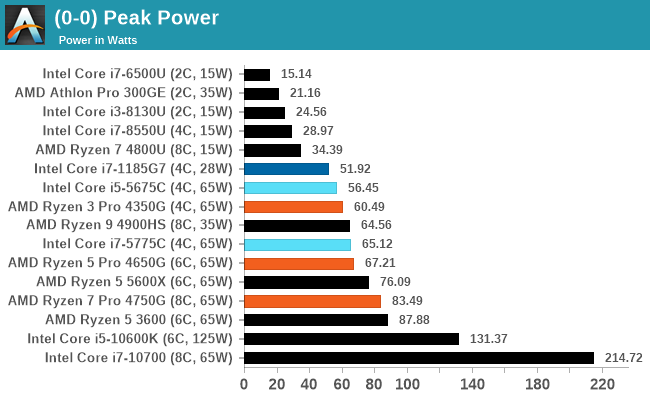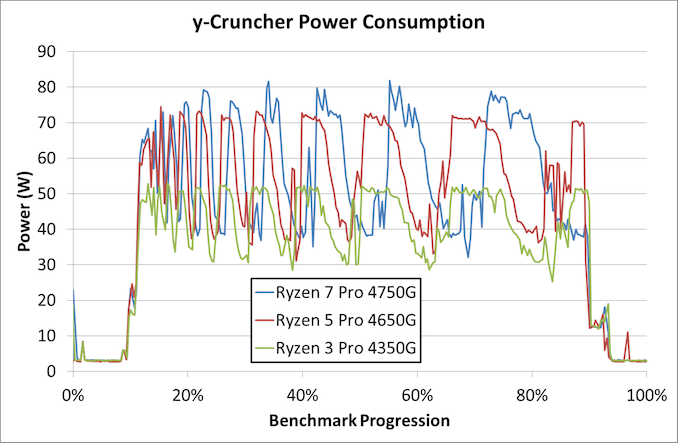Testing The World’s Best APUs: Desktop AMD Ryzen 4750G, 4650G and 4350G
by Dr. Ian Cutress on December 16, 2020 10:30 AM ESTPower Consumption
The nature of reporting processor power consumption has become, in part, a dystopian nightmare. Historically the peak power consumption of a processor, as purchased, is given by its Thermal Design Power (TDP, or PL1). For many markets, such as embedded processors, that value of TDP still signifies the peak power consumption. For the processors we test at AnandTech, either desktop, notebook, or enterprise, this is not always the case.
Modern high performance processors implement a feature called Turbo. This allows, usually for a limited time, a processor to go beyond its rated frequency. Exactly how far the processor goes depends on a few factors, such as the Turbo Power Limit (PL2), whether the peak frequency is hard coded, the thermals, and the power delivery. Turbo can sometimes be very aggressive, allowing power values 2.5x above the rated TDP.
AMD and Intel have different definitions for TDP, but are broadly speaking applied the same. The difference comes to turbo modes, turbo limits, turbo budgets, and how the processors manage that power balance. These topics are 10000-12000 word articles in their own right, and we’ve got a few articles worth reading on the topic.
- Why Intel Processors Draw More Power Than Expected: TDP and Turbo Explained
- Talking TDP, Turbo and Overclocking: An Interview with Intel Fellow Guy Therien
- Reaching for Turbo: Aligning Perception with AMD’s Frequency Metrics
- Intel’s TDP Shenanigans Hurts Everyone
In simple terms, processor manufacturers only ever guarantee two values which are tied together - when all cores are running at base frequency, the processor should be running at or below the TDP rating. All turbo modes and power modes above that are not covered by warranty. Intel kind of screwed this up with the Tiger Lake launch in September 2020, by refusing to define a TDP rating for its new processors, instead going for a range. Obfuscation like this is a frustrating endeavor for press and end-users alike.
However, for our tests in this review, we measure the power consumption of the processor in a variety of different scenarios. These include full AVX2/AVX512 (delete as applicable) workflows, real-world image-model construction, and others as appropriate. These tests are done as comparative models. We also note the peak power recorded in any of our tests.
First up is our image-model construction workload, using our Agisoft Photoscan benchmark. This test has a number of different areas that involve single thread, multi-thread, or memory limited algorithms.
Each of our three processors here seems to approach different steady state power levels for the different areas of the benchmark.
- The 8-core is around 65 W in the first stage, and more around 48 W in the second stage.
- The 6-core is around 51 W in the first stage, and more around 38 W in the second stage.
- The 4-core is around 36 W in the first stage, and more around 30 W in the second stage.
The fact that the difference between each of the processors is 14-15 W in the first stage would go a little to suggesting that we're consuming ~7 W per core in this part of the test, which is strictly multi-threaded. However when it moves more into variable threaded loading, all three CPUs are well below the TDP levels.
The second test is from y-Cruncher, which is our AVX2/AVX512 workload. This also has some memory requirements, which can lead to periodic cycling with systems that have lower memory bandwidth per core options.
The y-Cruncher test is a little different, as we're mostly concerned about peaks. All three CPUs have a TDP rating of 65 W, however the 8-core here breaches 80 W, the 6-core is around 72 W, and the only processor below that TDP value is the quad core Ryzen 3.
For absolute peak power across all of our tests:

For absolute instanteous peak power, each of the Ryzen R4000 APUs does what was expected - with the Ryzen 7 hitting the socket limit for 65 W processors.












104 Comments
View All Comments
Kuhar - Thursday, December 17, 2020 - link
I guess you two guys didn`t read the article, did you?! It states clearly about memory SPEED and about memory TIMINGS.29a - Thursday, December 17, 2020 - link
I know, it sucks. The reasoning is they think people who build their own computers wont go into the BIOS and enable XMP.BlueScreenJunky - Thursday, December 17, 2020 - link
My conclusion is that we need better low Power Consumption discrete GPUs. The GT1030 is over 3 year old and still faster than IGPs. If nvidia could release an RTX 3030 with a 30W TDP it would be perfect for small machines.nero10578 - Thursday, December 17, 2020 - link
Why would you not test 720p which is what people use integrated GPUs for? 1080p high is too high and 360p is well no one plays at that resolution. Also wouldn't it be better to test the GT 1030 using the APUs? To remove any performance differences coming from the CPU side which from a 2600 to a 4750G is massive.Fujikoma - Thursday, December 17, 2020 - link
Thank you for the review. These are typically the types of processors I use to build systems for older family members. Almost exclusively used for web-surfing, online purchases, You-Tube, Facebook, Office/Libre, burning music cds, simple/archaic games, and one individual using Photoshop. I will agree, as others have stated, that 720P really should be the minimum monitor size. Mainly because it's more expensive to find a monitor with lower resolution than a cheap 720P/768P/1080P LCD. I don't mind the 1080P max tests because it's nice to see what kind of a brick wall the iGPU will be hitting. I just finished computer builds for my brother and ex-wife, which left replacing other family from really old APUs systems. Now I know why I don't see much of a selection anymore. Shame, because I enjoy DIY over buying a basic box from an OEM and this just makes it more of a hassle.Superunknown9898 - Thursday, December 17, 2020 - link
Anyone else notice the Ryzen 4750G struggling to beat the 3600X in games but dominating in a few office benchmarks? I figured the 4750G would make a clean sweep seeing as it runs at identical frequencies to the 3600X but has more L1 and L2, two more cores plus a monolithic die.maindan - Thursday, December 17, 2020 - link
What a gross oversight not to include the new Apple M1 CPU here, which is essentially an APU.Inexcusable.
qlum - Thursday, December 17, 2020 - link
Not really the area of focus for anandtech but the 4700g has a small niche as being the best cpu for memory frequency records.Shivansps - Thursday, December 17, 2020 - link
I just logged in to say thtas the wrong way to way IGP perf... Resolutions for IGP are 720P/768P min/med and 900P min/med depending on the game, 1080p full is too much and anything below 720p is worthless. 900P tend to be the sweetspot in performance and quality for IGP, but not every game can be run at that resolution.Jacek Jagosz - Thursday, December 17, 2020 - link
Are those CPUs even supported on B450? ITX boards are much more expensive on B550 than B450, and if you want a PC with only APU inside then you don't want to spend too much on it.